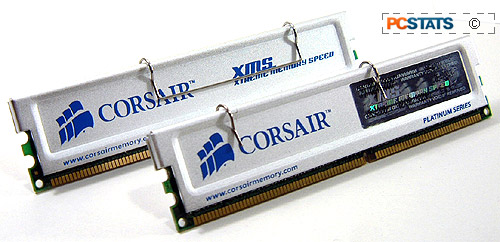It's great to see how individual memory stacks up
against one another under stock configuration, but we're also going to show how
they stack up to each other when overclocked. The results are listed below for
some of the recent memory to cross PCSTATS' test bench. All memory was tested at
its most lax timings as well as its most aggressive. In terms of best overall
overclocking performance, PCStats currently gives more weight to the combination
of moderately high speeds and low latencies (2-2-2-5) than high speeds at the
expense of latency timings.
Higher
density DIMMs tend to be more difficult to overclock than 512MB modules. The
Corsair TwinX2048-4000PT memory does well here relative to other 1GB modules we
have tested. If you're a hardcore gamer, 2GB of memory is certainly looking like
the way of the future, and its nice to see that there are options.
 Conclusions
Conclusions
With games like Battlefield 2 demanding upwards of
600-800MB of system memory, that leaves very little for the OS and other
applications that might be running in the background. This is generally why 2GB
RAM modules show such a lead in this benchmark. If you would like to test your
system with Battlefield 2, you can learn how to benchmark it here.
At 200 MHz the dual channel Corsair
TwinX1024-4000PT DDR memory modules are able to run with moderately tight
2.5-3-3-6 memory timings. If you're an overclocker though, the memory is rated
to run at 250 MHz with 3-4-4-8 timings as long as the supporting hardware is
capable. The units we tested had no problems achieving a speed of 255 MHz with
tighter timings, and 290 MHz with default timings (3-4-4-8) in our labs.
|
experts tip: dominant overclocking
modules |
| dual channel ddr memory overclocking
on athlon64 platforms can become a little tricky at times because there is
generally always one memory module that is stronger at overclocking
than the other. to find out which memory module is the dominant
overclocker in a pair of dual channel ddr, do the usual
memory/timing tests with each individual stick alone, in single channel
mode. note which module overclocks less, and when running in a dual
channel configuration place that module in the dimm slot closest to
the processor. rumor has it that the memory channel closest to the
processor allegedly handles the weaker overcloking memory better than
the outer slot. does this work for you? please let us know in the PCStats forums. |
| Comments and Feedback? Suggest a
Tweak. |
With applications and games using up more system
resources, the transition towards 2GB of system memory is upon us. For
enthusiasts, memory like the Corsair TwinX2048-400PT just makes that move easier. Of course
enthusiasts who want the best always have to pay a price premium and with a
retail price of $276 CDN ($230 US), the memory is priced
a bit higher than generic DDR memory.
Judging by the results we've seen here though, these
modules are a good choice for anyone looking to make the 2GB transition, but who
still want to overclock their memory for that 'extra' performance edge.
Find out
about this and many other reviews by joining the Weekly PCstats.com
Newsletter today! Catch all of PCstats latest hardware reviews right
here.
Related Articles
Here are
a few other articles that you might enjoy as well...
1. OCZ 2GB PC4000 EL DDR Gold Memory Review
2. OCZ Technology EL-DDR PC3500 Gold GX
Memory Review
3. Corsair TwinX2048-6400 PRO PC2-6400 DDR-2 Memory Review
Review
4. Introducing FB-DIMM Memory: Birth of Serial RAM?
5. OCZ PC4800 Dual Channel Platinum Limited Edition Memory
